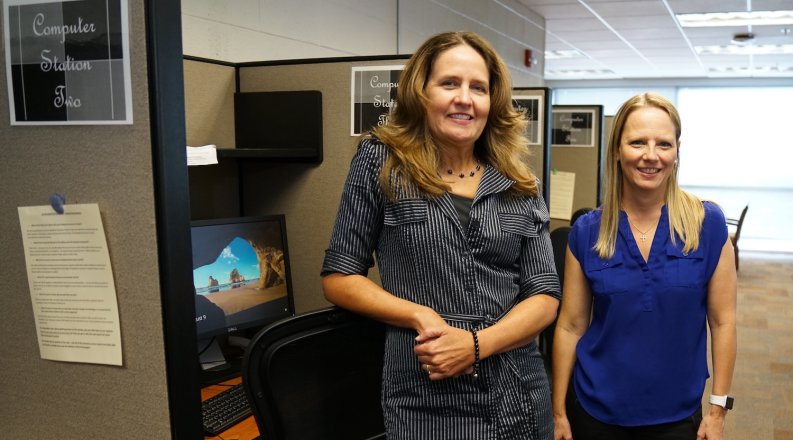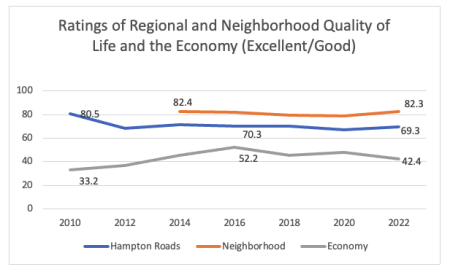Since its inception 25 years ago, Old Dominion University’s Social Science Research Center has posed a mountain of questions and parsed a vast ocean of survey data.
Through it all, the center’s mission has remained the same: help Hampton Roads understand itself.
With just two fulltime staffers — augmented with graduate students and temporary workers — this small center has made an oversized impact on the public conversation.
ODU political science professor Jesse Richman points to the center’s annual Life in Hampton Roads survey as Exhibit A.
“It provides an unrivaled perspective on the changing attitudes and perceptions of people living in the region,” he said. “As the survey has continued for many years, it is now possible to trace changes across time in the answers to key questions.”
By keeping methodology steady, the center identifies significant trends.
Life in Hampton Roads survey data confirms, for example, that frustration over traffic woes in Hampton Roads has grown since 2010. That year, 46.5 percent of respondents said they avoided visiting a neighboring city due to concerns about traffic congestion.
By 2022, that number jumped to 49.6 percent.
“The Life in Hampton Roads survey has become an institution in the local area, providing important and regular insights into issues affecting quality of life of Hampton Roads residents,” said Wie Yusuf, a professor in ODU’s School of Public Service, Strome College of Business.
Now in its 14th year, the survey has dependably tracked regional opinions on issues ranging from policing and traffic to healthcare, education, flooding, and the local economy.
To gather data for Life in Hampton Roads, the Social Science Research Center hires a team of 15-20 part-timers who place telephone calls and ask residents as many as 60 predetermined questions.
Release of the survey results can create a buzz of local media interest.
Championed by a former faculty director of the center, Xiushi Yang, the Life in Hampton Roads project offers both a big-picture view of attitudes in the region as well as granular, city-specific numbers.
“The longevity of it has been great to see,” said the center’s director, Tancy Vandecar-Burdin, describing the Life in Hampton Roads survey. “It’s good to see the data being used so widely — for research and public awareness.” Statistics from the ODU Digital Commons show that parts of the Life in Hampton Roads report have been downloaded more than 1,500 times since 2018.
While that survey project generates headlines, the center conducts an array of other research work for a broad range of partners and customers.
“Its research efforts are so eclectic that I don’t believe they can be described in a quick sound bite,” said Randy Gainey, an ODU professor in sociology and criminal justice who has been involved with the center since its inception.
“In addition to numerous reports prepared for state level agencies, the center has worked directly with most of the cities in Hampton Roads in one form or another — mostly on some important social issue … youth issues generally, crime, criminal justice and community engagement.”
Community engagement represents one of the center’s strength Gainey said.
Several years ago, leaders in Norfolk became concerned about youth violence. They asked ODU and the Social Science Research Center to help them assess the problem. The center helped gather responses from residents, civic leagues and church groups. Later, it gathered similar data for Portsmouth.
“The ability to work with — not necessarily for — communities is so valuable,” Gainey said.
The center has also proved its value as a vehicle for collaboration among different segments of the university and offers an avenue for ODU to conduct collaborative research with other universities.
Vandecar-Burdin has witnessed much of the center’s growth and success over the past 25 years. She’s been around almost from the very beginning.
The Social Science Research Center was founded in July 1998 by a former ODU assistant vice president for research and graduate studies, the late Carole Seyfrit. She wanted to expand the university’s research footprint while also giving graduate students real-life research experience.
“It was her brainchild,” Vandecar-Burdin said.
When hiring an associate director, Seyfrit turned to a familiar face.
“I worked for her when I was working on my master’s degree at ODU,” Vandecar-Burdin said. “I had graduated and was working outside of academia. She came to me and said, ‘I’m thinking about starting this research center. We’re doing a national search for a director. I’d like you to come on as associate director. I don’t know if you’ll have a job in a year or two, but this is what we’re trying to do.’”
That remarkably honest pitch worked. Vandecar-Burdin joined the team as associate director and continued in that role until she was promoted to director in 2019.
On campus, admiration for the quality and impact of the center’s work is widespread.
“For 25 years, the SSRC has delivered high-quality data collection and analysis to users at ODU, in Virginia, and throughout the United States,” Richman said. “As a former director, I can say I am proud to have had the opportunity to work with the SSRC team, and I love the opportunity to continue to work with them on projects periodically.”
Vandecar-Burdin said she and long-time senior project coordinator Wendi Wilson-John observed the center’s 25th anniversary in July by doing what they always do: chasing data, collaborating with colleagues, and spotting trends.
“I would love it if someone threw us a party, but that’s OK,” she said, smiling. Challenging, community-supporting work brings its own rewards.
“It’s a moment of pride for the center, and for me personally and professionally, that I’ve been part of something that’s lasted for 25 years,” Vandecar-Burdin said. “Hopefully, it will continue for another 25 years.”




